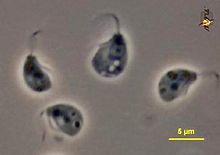Malawimonadidae
| Malawimonadidae | |
|---|---|

| |
| Malawimonas jakobiformis | |
| Scientific classification | |
| Domain: | Eukaryota |
| Kingdom: | Malawimonada |
| Phylum: | Malawimonada |
| Class: | Malawimonadea |
| Order: | Malawimonadida |
| Family: | Malawimonadidae O’Kelly & Nerad 1999 |
| Genera | |
Malawimonadidae is a family of unicellular eukaryotes of outsize importance in understanding eukaryote phylogeny.
Malawimonadidae is a unique and relatively lesser-known group of flagellate protists belonging to the phylum Malawimonada. These organisms are single-celled eukaryotes that are found in various aquatic habitats, including freshwater environments and marine systems.
Several features make Malawimonadidae unique:
Evolutionary position: Malawimonads are considered to be one of the earliest branching lineages of eukaryotes. This makes them particularly interesting for researchers studying the early evolution of eukaryotic cells and their organelles.
Feeding mechanism: Malawimonads are known to be bacterivorous, meaning they feed on bacteria. They possess a unique feeding apparatus called the "malawimonad mastigont system," which is a complex of microtubules, flagella, and other cellular structures that facilitate the capture and ingestion of bacteria.
Flagella arrangement: Malawimonad cells typically have two flagella that are inserted close to each other. One flagellum is directed towards the anterior part of the cell, while the other is directed posteriorly. This flagellar arrangement is unique among protists and is used for both locomotion and feeding.
Mitochondrial relics: The mitochondria in Malawimonadidae are unusual in that they have reduced, highly derived cristae. [2][3][4][5]
Phylogeny
[edit]| Scotokaryota |
| ||||||||||||||||||||||||||||||||||||||||||||||||||||||
References
[edit]- ^ Heiss, Aaron A.; Kolisko, Martin; Ekelund, Fleming; Brown, Matthew W.; Roger, Andrew J.; Simpson, Alastair G. B.; et al. (2018). "Combined morphological and phylogenomic re-examination of malawimonads, a critical taxon for inferring the evolutionary history of eukaryotes". Royal Society Open Science. 5 (4): 171707. Bibcode:2018RSOS....571707H. doi:10.1098/rsos.171707. PMC 5936906. PMID 29765641.
- ^ "Malawimonadidae". Retrieved 2009-03-08.
- ^ Ruggiero; et al. (2015), "Higher Level Classification of All Living Organisms", PLOS ONE, 10 (4): e0119248, Bibcode:2015PLoSO..1019248R, doi:10.1371/journal.pone.0119248, PMC 4418965, PMID 25923521
- ^ Silar, Philippe (2016), "Protistes Eucaryotes: Origine, Evolution et Biologie des Microbes Eucaryotes", HAL Archives-ouvertes: 1–462
- ^ Heiss, Aaron A.; Kolisko, Martin; Ekelund, Fleming; Brown, Matthew W.; Roger, Andrew J.; Simpson, Alastair G. B.; et al. (2018). "Combined morphological and phylogenomic re-examination of malawimonads, a critical taxon for inferring the evolutionary history of eukaryotes". Royal Society Open Science. 5 (4): 171707. Bibcode:2018RSOS....571707H. doi:10.1098/rsos.171707. PMC 5936906. PMID 29765641.
- ^ Cavalier-Smith T (2013). "Early evolution of eukaryote feeding modes, cell structural diversity, and classification of the protozoan phyla Loukozoa, Sulcozoa, and Choanozoa". Eur J Protistol. 49 (2): 115–78. doi:10.1016/j.ejop.2012.06.001. PMID 23085100.
- ^ Brown, Matthew W; Heiss, Aaron A; Kamikawa, Ryoma; Inagaki, Yuji; Yabuki, Akinori; Tice, Alexander K; Shiratori, Takashi; Ishida, Ken-Ichiro; Hashimoto, Tetsuo (2018-01-19). "Phylogenomics Places Orphan Protistan Lineages in a Novel Eukaryotic Super-Group". Genome Biology and Evolution. 10 (2): 427–433. doi:10.1093/gbe/evy014. ISSN 1759-6653. PMC 5793813. PMID 29360967.

